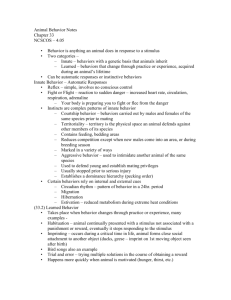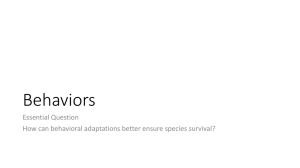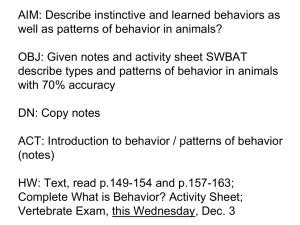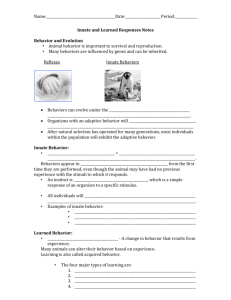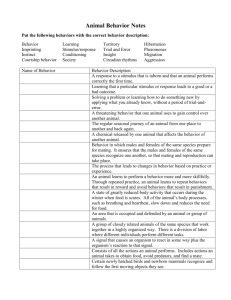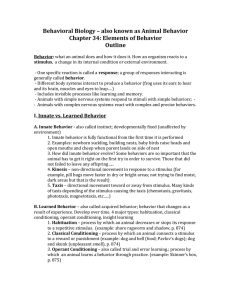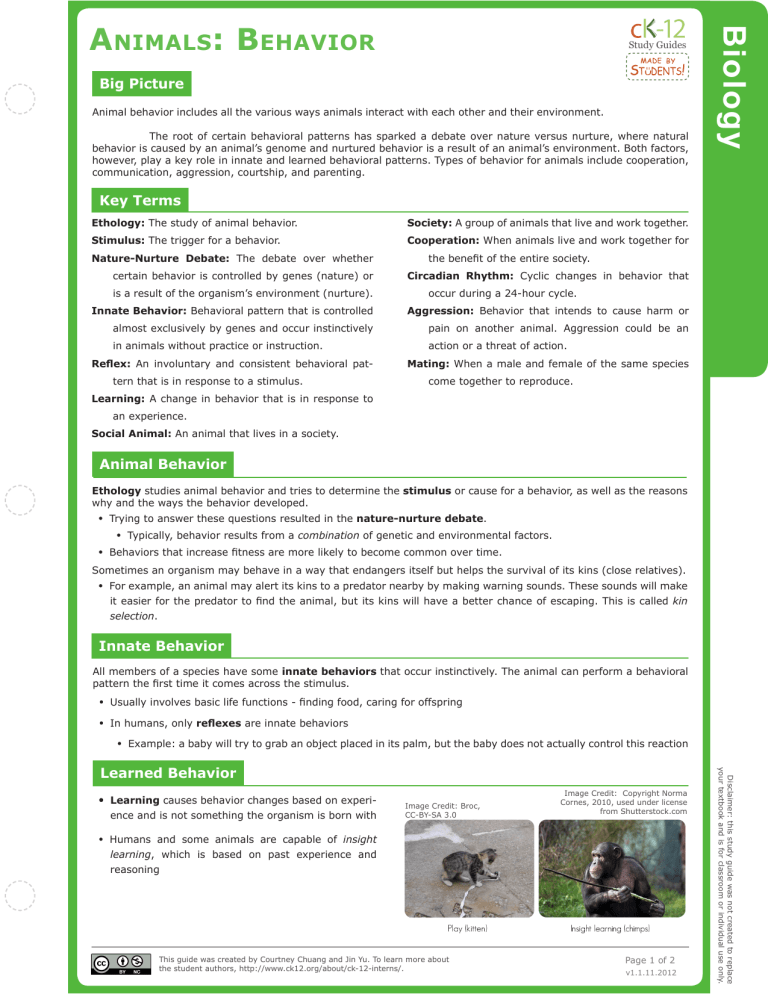
Study Guides Big Picture Animal behavior includes all the various ways animals interact with each other and their environment. The root of certain behavioral patterns has sparked a debate over nature versus nurture, where natural behavior is caused by an animal’s genome and nurtured behavior is a result of an animal’s environment. Both factors, however, play a key role in innate and learned behavioral patterns. Types of behavior for animals include cooperation, communication, aggression, courtship, and parenting. Biology Animals: Behavior Key Terms Ethology: The study of animal behavior. Society: A group of animals that live and work together. Stimulus: The trigger for a behavior. Cooperation: When animals live and work together for Nature-Nurture Debate: The debate over whether certain behavior is controlled by genes (nature) or is a result of the organism’s environment (nurture). the benefit of the entire society. Circadian Rhythm: Cyclic changes in behavior that occur during a 24-hour cycle. Innate Behavior: Behavioral pattern that is controlled Aggression: Behavior that intends to cause harm or almost exclusively by genes and occur instinctively pain on another animal. Aggression could be an in animals without practice or instruction. action or a threat of action. Reflex: An involuntary and consistent behavioral pattern that is in response to a stimulus. Mating: When a male and female of the same species come together to reproduce. Learning: A change in behavior that is in response to an experience. Social Animal: An animal that lives in a society. Animal Behavior Ethology studies animal behavior and tries to determine the stimulus or cause for a behavior, as well as the reasons why and the ways the behavior developed. • Trying to answer these questions resulted in the nature-nurture debate. • Behaviors that increase fitness are more likely to become common over time. • Typically, behavior results from a combination of genetic and environmental factors. Sometimes an organism may behave in a way that endangers itself but helps the survival of its kins (close relatives). • For example, an animal may alert its kins to a predator nearby by making warning sounds. These sounds will make it easier for the predator to find the animal, but its kins will have a better chance of escaping. This is called kin selection. Innate Behavior All members of a species have some innate behaviors that occur instinctively. The animal can perform a behavioral pattern the first time it comes across the stimulus. • Usually involves basic life functions - finding food, caring for offspring • In humans, only reflexes are innate behaviors • Example: a baby will try to grab an object placed in its palm, but the baby does not actually control this reaction • Learning causes behavior changes based on experience and is not something the organism is born with • Humans and some animals are capable of insight learning, which is based on past experience and reasoning Image Credit: Broc, CC-BY-SA 3.0 This guide was created by Courtney Chuang and Jin Yu. To learn more about the student authors, http://www.ck12.org/about/ck-12-interns/. Image Credit: Copyright Norma Cornes, 2010, used under license from Shutterstock.com Page 1 of 2 v1.1.11.2012 Disclaimer: this study guide was not created to replace your textbook and is for classroom or individual use only. Learned Behavior Biology Animals: Behavior cont . Types of Animal Behavior Social Behavior and Cooperation • Social animals live together in groups called societies. • Through cooperation, they live and work together for the benefit of the entire society. • Each animal has a specific role. Communication • Animals communicate with each other to convey information. • Communication can be visual, auditory, or chemical. Aggression Aggression may result from competition over the same resources. • Intraspecific competition is competition between members of the same species. • Interspecific competition is competition between members of different species. Mating and Courtship When animals are mating, usually the male needs to attract the female. Males may put on courtship displays by performing certain rituals to attract a mate. • Example: Male peacocks display their colorful tails to attract the less colorful females. Parental Care In birds and mammals, parental care is common. Usually the mother provides care, but sometimes the father or both parents are the primary caretaker. • Mammals generally have longer parental care, teaching their offspring how to survive. Image Credit: Left image copyright XuRa, 2010, right image copyright Mariko Yuki, 2010, used under licenses from Shutterstock.com Cyclic Behaviors Many animal behaviors are cyclic, or occur in a regular cycle. Examples of cyclic behaviors: • Human body temperature show circadian rhythm - the temperature changes in a regular way in a 24-hour period (a day). • Many animals migrate to find food or mate. They travel long distances from one habitat to another in a seasonal pattern. Notes Page 2 of 2 Image Credit: L. Shyamal, Public Domain
